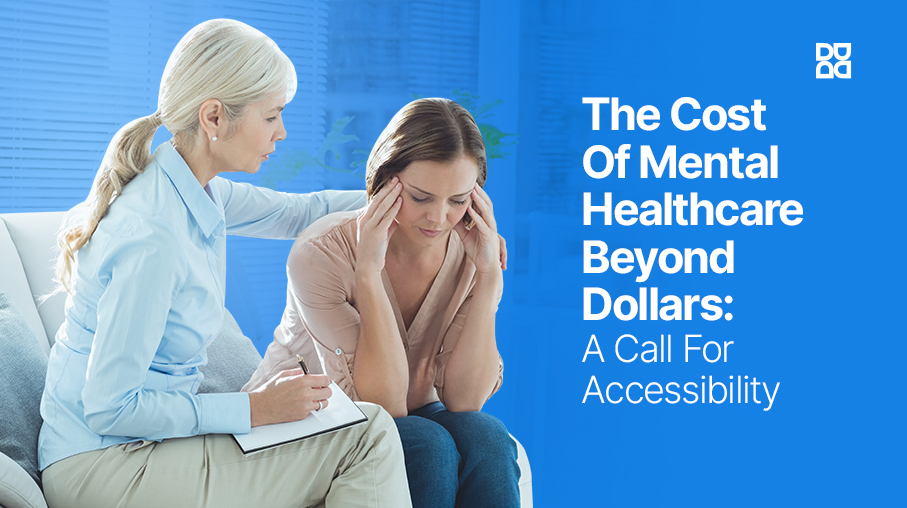
More than 1 in 5 US adults live with a mental illness. And about 1 in 25 U.S. adults suffer from serious mental illness, such as schizophrenia, bipolar, or major depression.
That's not all, over 1 in 5 youth (age 13-18), either currently or at some point during their life, have had a seriously debilitating mental illness.
And the impact? It extends beyond just hindering the individual's day-to-day life, which in itself is concerning enough.
Yes, the repercussions include:
- Global impact on the economy: Depression and anxiety cause approximately $1 trillion in lost productivity annually on a global scale.
- Dreadful Implications: As of 2020, suicide is the second leading cause of death for U.S. children, aged 10 to 14, preceded only by unintentional injury.
- Long-Term Behavioral Implications: Approximately 5.2 million veterans were predicted to experience a behavioral health condition in 2022.
| It is, in fact, a crisis. And 90% of Americans agree, according to the results of a CNN/Kaiser Family Foundation poll. |
What Is A Mental Health Crisis?
On an individual level, it often refers to an inability to cope with physical, mental, and emotional stress, and as a result, an incapacity to function effectively. However, on a national level, it may be interpreted as its ineptitude to provide access to mental health care and ensure the well-being of its citizens.
Potential Reasons?
- Inequitable access to mental health care.
- Unaffordable costs.
- Outdated and ineffective mental health care system.
The Demographic Differences In Mental Health
Even though all Americans are prone to developing mental health issues, most conditions are more prevalent in certain demographics than others.
Mental Health Differences By Gender
According to a 2021 study, mental illness was more prevalent among women than men. That's right, certain mental health conditions, like depression and bipolar disorder, affect more women than men. On the other hand, men are more likely to report symptoms such as fatigue, irritability, and loss of interest rather than feelings of sadness.
Mental Health Differences Among Multiracial Adults
A similar study revealed that in 2022, multiracial adults in the U.S. were more likely to experience any mental illness the year prior (35.2%). Additionally, here's a breakdown of the likelihood of certain racial or ethnic groups experiencing mental health issues:
- White (24.6%)
- Hispanic (21.4%)
- Black (19.7%)
- American Indian or Alaska Native (19.6%)
- Asian (16.8%)
Mental Health Issues Among LGBTQ Community
These differences extend beyond gender and ethnicity. For instance, the pervasiveness of mental issues may be more common in the LGBTQ community according to several studies.
- 50% of adults who identify as lesbian, gay, or bisexual (LGB) experienced a mental health condition in 2020. Additionally, they were more than twice as likely to experience a mental health condition than heterosexual adults.
- Alarmingly, transgender adults are nearly four times as likely to experience a mental health condition.
Stigma Around Seeking Mental Health Care
Even today, there's a certain stigma attached to mental health issues, and seeking mental health care isn't as accepted or encouraged as physical healthcare. So, when defining ‘what does it mean to be healthy?’ mental health is often overlooked.
Further, lack of awareness and taboos keep people from reaching out for help. 'Why should someone seek professional help for issues related to mental health?' is a question often asked with a condescending tone. And the 'weakness' perception, fear of judgment, and labels stifle open discussions. So, an overlooked answer to 'how to make mental healthcare more accessible?' is to fight the stigma attached to it.
Behavioral Health Vs Mental Health: Addressing a Common Misconception
A prevailing fallacy when it comes to mental health is that it is the same as behavioral health. This distorts the interpretations of mental health, undermining their effect on people.
Here's a quick comparison of behavioral health vs mental health for your better understanding.
| Aspect | Mental/Psychological Health | Behavioral Health |
|---|---|---|
| Focus | Primarily focuses on mental and emotional well-being, diagnosis, and treatment of psychological disorders. | Takes a broader approach, encompassing mental, emotional, and behavioral aspects of health and wellness. |
| Treatment Approach | Utilizes psychotherapy, counseling, and other talk therapies as primary treatment modalities. | Incorporates a range of interventions including psychotherapy, medication management, behavioral interventions, and lifestyle changes. |
| Conditions Treated | Treats conditions such as depression, anxiety disorders, bipolar disorder, PTSD, etc. | Addresses a wider range of conditions including substance abuse, addiction, eating disorders, developmental disorders, etc. |
| Professionals Involved | Psychologists, psychiatrists, counselors, therapists, social workers. | Psychologists, psychiatrists, counselors, therapists, psychiatric nurses, addiction specialists, social workers. |
| Emphasis | Emphasized understanding thoughts, emotions, and behaviors to promote mental wellness and alleviate distress. | Emphasized changing behaviors, thoughts, and emotions to improve overall well-being and functioning. |
| Setting | Services often provided in outpatient clinics, private practices, hospitals, and community mental health centers. | Services provided in various settings including outpatient clinics, hospitals, residential treatment facilities, community health centers, and telehealth platforms. |
| Insurance Coverage | Covered by most health insurance plans, although coverage may vary depending on the provider and plan. | Covered by most health insurance plans, but coverage may also vary depending on the specific services and conditions treated. |
| Preventive Measures | Focuses on early detection and intervention to prevent the escalation of mental health issues. | Integrates preventive measures to address risk factors and promote healthy behavioral and mental health problems. |
Understanding Rare Mental Disorders: Borderline Schizophrenia And Bipolar Disorder
To put it plainly, rare mental disorders are more common than you think. And it is important to understand that each disorder that falls under psychological healthcare is unique. And there's no way to know what's the worst mental illness. However, comprehending them to be more empathetic towards those who endure them is important.
We won't exactly be diving into the 5 stages of psychosis, but here's a quick overview of the rare mental disorders:
Schizophrenia Vs Bipolar
| Characteristic | Borderline Schizophrenia | Bipolar Disorder |
|---|---|---|
| Definition | A condition characterized by a mix of symptoms from both schizophrenia and borderline personality disorder. | A mood disorder characterized by periods of elevated mood (mania) and periods of depression. |
| Core Symptoms | Paranoia, disorganized thinking, hallucinations, and emotional instability. | Episodes of mania (elevated mood, impulsivity, racing thoughts) altering with episodes of depression. |
| Onset | Typically manifests in late adolescence or early adulthood. | Usually begins in late adolescence or early adulthood, but can occur at any age. |
| Mood Stability | Mood instability often fluctuates rapidly within a short period. | Mood shifts occur over longer periods, typically weeks to months. |
| Reality Perception | May have difficulty distinguishing reality from fantasy but may not completely lose touch with reality. | Generally maintains a grasp on reality during mood episodes, although psychotic symptoms can occur during severe episodes. |
| Relationship Patterns | Tendency towards intense, unstable relationships, fear of abandonment, and difficulties with self-image. | Interpersonal relationships may be strained during mood episodes, but stability between episodes is common. |
| Treatment Approach | Typically involves a combination of antipsychotic medications, mood stabilizers, and therapy focusing on coping skills and reality testing. | Often treated with mood stabilizers, antidepressants, antipsychotics (for manic episodes), and therapy such as cognitive-behavioral therapy or psychoeducation. |
| Prognosis | The prognosis varies; some individuals may achieve significant improvement with treatment, while others may have chronic symptoms. | With proper treatment and management, many individuals with bipolar disorder can lead productive lives, though recurrence of mood episodes is common. |
The Overbearing Cost Of Mental Healthcare: Affordability and Accessibility In Question
If the stigma weren't enough to keep individuals from seeking mental healthcare, the cost surely poses an even bigger issue.
In fact, the most common reason for U.S. adults to not receive mental health treatment is their inability to afford the cost.
According to Integrative Life Center, almost four in ten US adults say they have trouble affording health care costs. Moreover, mental health care is often more expensive than physical care costs. Insurance not covering it the same way only adds to the issue. Resultantly, with so much dependence on out-of-pocket costs, as is in many cases, mental health care may only be accessible to those with higher incomes.
But is it really that expensive? Before answering that, it’s imperative to understand how much does a psychiatrist cost, how much does a mental hospital cost without insurance, and so on. Let’s give you a general idea of the cost of mental healthcare.
How Much Does Mental Healthcare Cost?
According to CNBC, a traditional therapy session can cost between $65 and $250 per hour for those without insurance. However, this is only an estimate of one short session. The cost implications of mental health issues can be extensive, depending on the type and severity of the illness. For instance, a patient with major depression may have to spend an average of $10,836 a year on psychological healthcare costs.
Here's a simplified breakdown of the average costs of mental healthcare:
| Facet Of Mental Health Treatment | Cost Range |
|---|---|
| Therapy Sessions | $75- $200 per session |
| Psychiatric Evaluation | $200-$500 per session |
| Medication | $20 - $200+ per month |
| Hospitalization | $1,000 - $2,000 per day |
| Partial Hospitalization Program (PHP) | $500 - $1,000 per day |
| Intensive Outpatient Program | $100 - $500 per session |
| Support Groups | Free - $50 dollars per session |
| Alternative Therapies | $50 - $150 per session |
| Teletherapy | $50 - $150 per session |
| Case Management | $50 - $150 per hour |
Catalyze Better Access To Mental Healthcare With Denefits
With more people recognizing the importance of mental health, the need for psychological healthcare is growing more than ever. However, cost remains a factor holding individuals back from receiving the care they deserve, especially those who do not have insurance or if their insurance does not cover it. This is where mental healthcare providers need to step in and take the lead in improving access to their services. How? Enter Denefits with its flexible payment plans - enabling providers to allow their patients to pay for mental healthcare services in manageable monthly installments.
How Does ‘Denefits’ Help Providers Improve Mental Healthcare Access?
- Denefits provides No Credit Check financing, allowing mental health care providers to help patients, regardless of their credit score.
- It ensures everyone has access to mental healthcare, irrespective of their financial circumstances with their different financing options.
- Denefits empowers mental health providers with the opportunity to tailor payment plans, allowing for flexible payments towards the services.
- Denefits has a 95% approval rate, instilling patients with confidence by subsiding the fear of rejection.
- Denefits offers multilingual support in payment technology, allowing providers to cater to a diverse audience, increasing reach, and enhancing the overall patient experience.
Conclusion
The pervasive nature of mental health issues across various demographics highlights the need for improved access to mental healthcare. Stigma, cost barriers, and misconceptions surrounding mental health continue to hinder individuals from seeking the help they need. Addressing these challenges requires not just healthcare providers but also society to step up. Moreover, by promoting awareness, fighting stigma, and implementing innovative solutions like Denefits, improved mental healthcare accessibility and affordability can be achieved.


